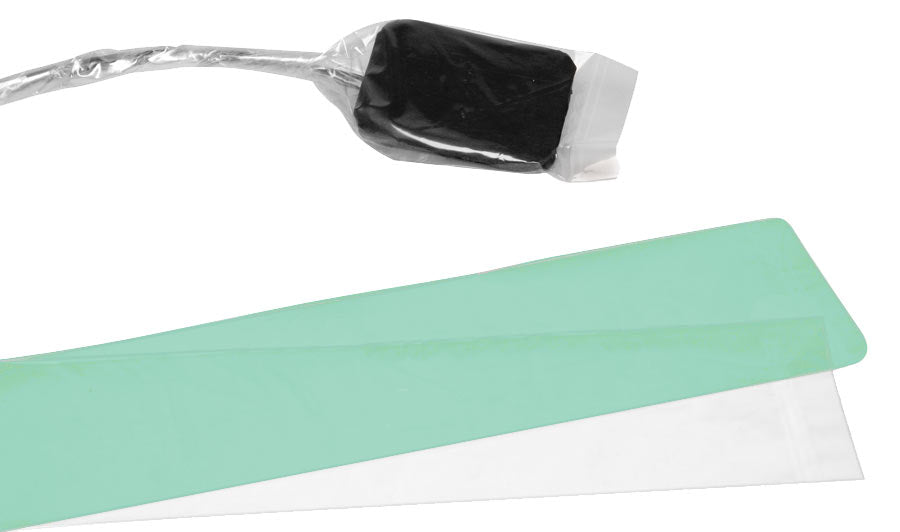X-ray sensors are a valuable addition to your diagnostic toolbox. However, digital sensors are a serious investment and can carry a significant price tag. Taking care of and protecting your x-ray sensors from is important. So, what can you do to protect your sensor investment?
Ways to Take Care of Sensors
1. USE BARRIERS:
Because you use sensors intra-orally, they are classified as semi-critical items (see Practice Tip #76 for more explanation). As sem-critical items, they need to be: disposable, sterilized between patients, disinfected, or covered with barriers. Obviously, you don’t throw the sensor away after each patient and buy a new one. Digital sensors will NOT withstand heat sterilization, so this isn’t an option either. This leaves the options of disinfecting or using barriers. Disinfectants are harsh and will lead to damage of the sensor. Barriers will not only protect patients and staff from cross-contamination, but they will also serve to protect the sensor from moisture and debris. The use of barriers is the best option to keep your sensor free from harm, while maintaining infection control standards.

PHOTO: Protect x-ray sensors with the help of plastic barriers.
2. STORE PROPERLY:
Exercise care in storing your sensor. If a cord is integrated into the sensor, make certain to carefully coil the cord when storing. Leave the last few inches of the cord (where it connects to the sensor) as straight as possible. This connection is one of the most fragile points of the assembly. Avoid stressing this connection if you can. The cord should be looped into a loose circle (take care not to bend or kink it). The entire sensor and cord can be hung on a wall hook, stored in a small plastic case, or even placed on a covered set-up tray to keep it out of the way, but still protected. Placing a sensor loose in a drawer or container with other items can lead to damage and should be avoided.
 PHOTO: A cord saver (#XH-74) prevents the cord from being kinked during use and while being stored.
PHOTO: A cord saver (#XH-74) prevents the cord from being kinked during use and while being stored.3. HANDLE PROPERLY:
Always exercise caution when handling your sensor. Avoid tugging on the cord or connectors, this will put stress on them and can lead to damage or wear. Be careful when removing the sensor and cord from or placing into storage containers. Take special care that the cord isn’t pinched or abraded. As with most electronics and computer accessories, keep away from strong magnetic fields – NOTE: many bur blocks are magnetic, so keep away from bur set-ups.
4. BE PATIENT:
Take the time to properly position your sensor intra-orally on your patient. The quickness that digital imaging provides can make you want to rush it, but use the extra time afforded to make certain the sensor is properly positioned to achieve an appropriate diagnostic image. Use of intra-oral holders for your sensor will aid in positioning and help avoid damage from patients inadvertently biting on the sensor or cord. American Dental Accessories offers a wide range of holders designed for specific makes and model of sensor, as well as universal holders that allow use of many brands of sensor with a single holder system. Some holders will work with cone paralleling systems and will improve your x-ray technique.
5. BE AWARE OF THE WARRANTY:
Take note of the manufacturer’s warranty. Keep your purchase receipts and warranty paperwork in a central location should you need it. Purchasing a manufacturer’s extended warranty may give you additional protection, but you should also take note of sensors that offer a good warranty without any additional expense (like Suni).
6. DON'T TRY TO SERVICE IT:
This is not something we often say, as we like to encourage a DIY approach to many situations, but there is very little in a sensor that is user-serviceable. Most manufacturers will void their warranty if there is any evidence of tampering by an end user or third party. If a sensor needs repair, send to the manufacturer for service.
7. SECURE TECHNOLOGY:
Naturally, your sensor needs to be used with a computer, whether on a network or a stand alone system. Make certain to keep your hardware secure and keep software updated with regular operating system and anti-virus updates. As with the sensor, take care to avoid damaging your other hardware with which the sensor will need to interact. Regular back-ups of your data are also crucial when using digital systems. Quality record keeping is one of the perks of going digital.
Digital dentistry is evolving and possibly costly if you don't keep your technology in a pristine condition. Make sure you take the right steps to take care of and protect your x-ray sensors from wear and misuse.


LEAVE A REPLY